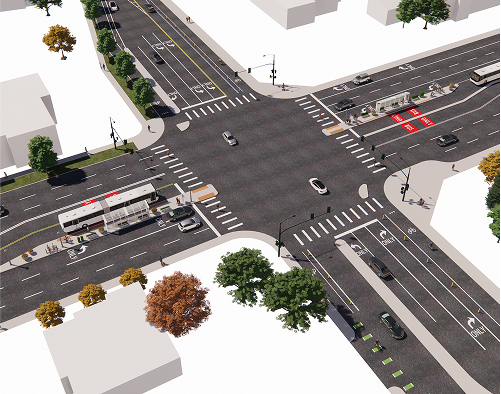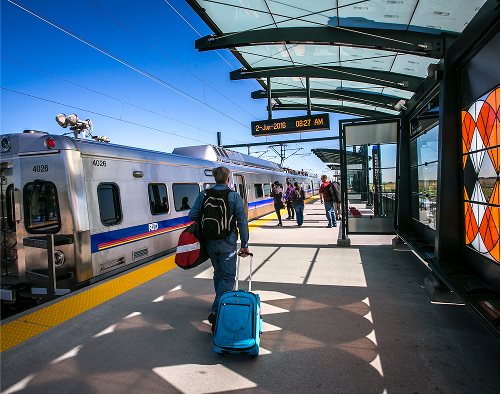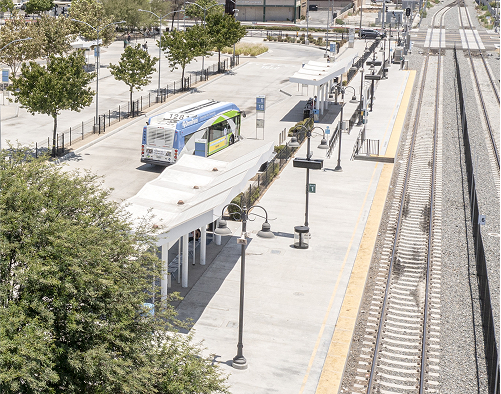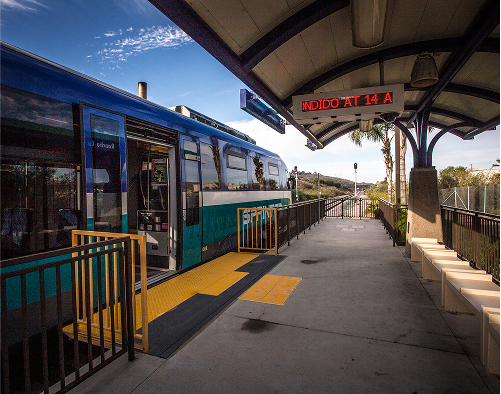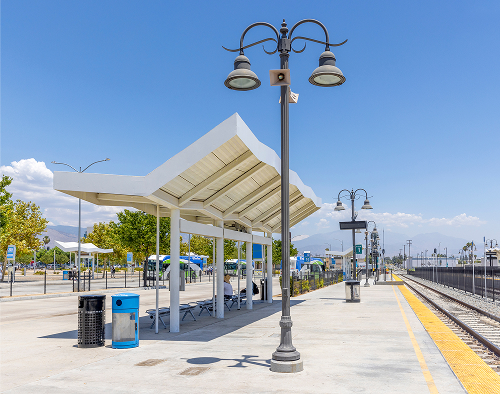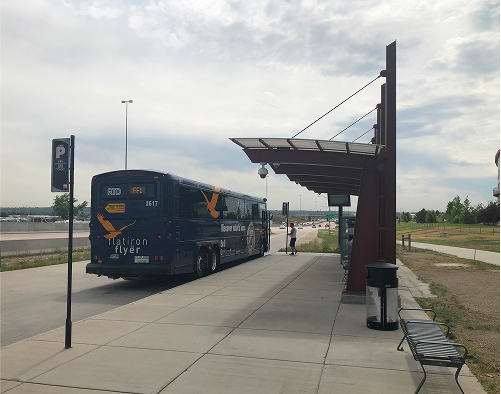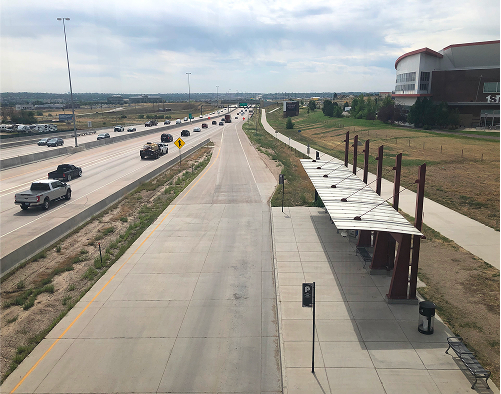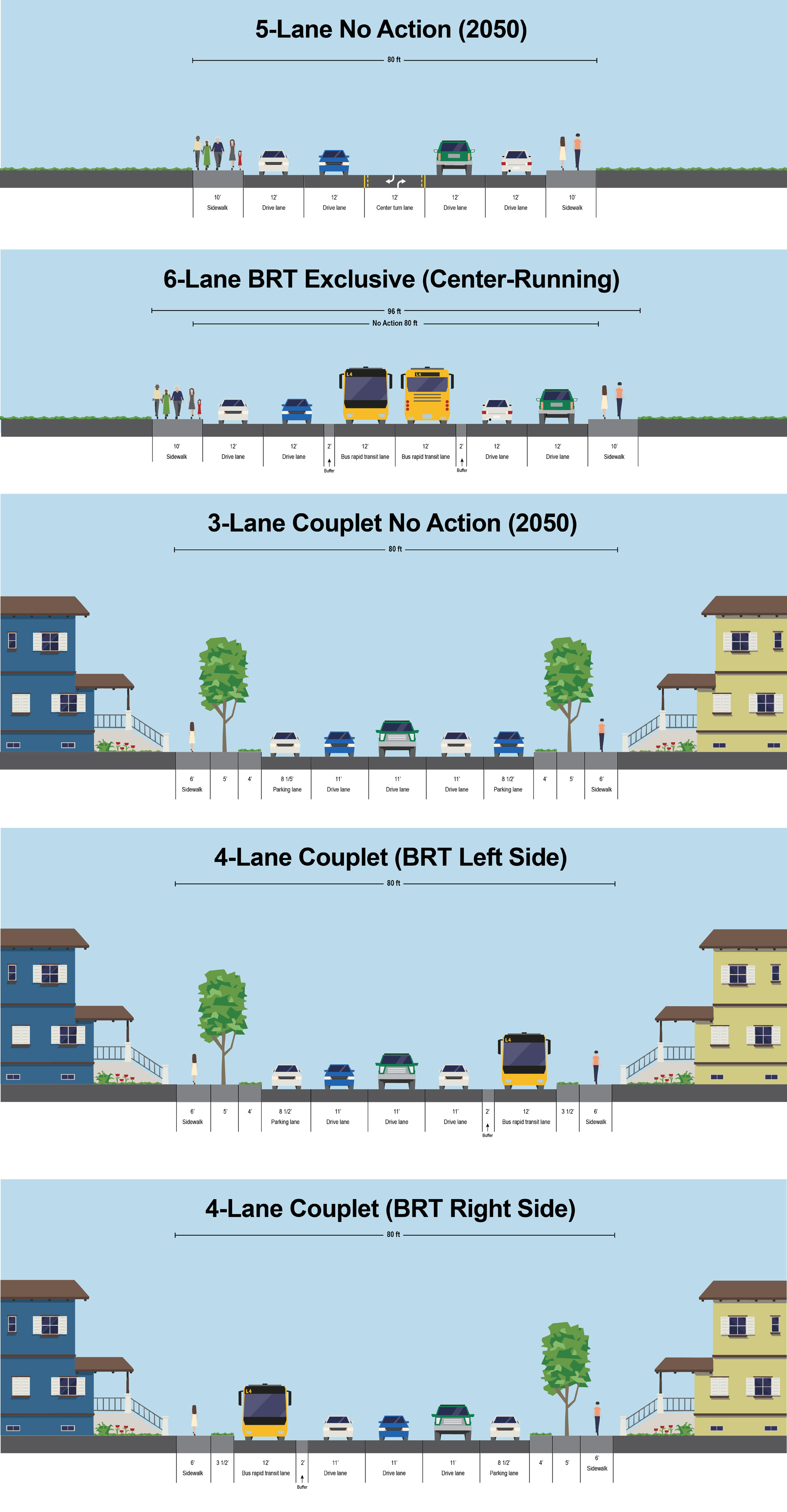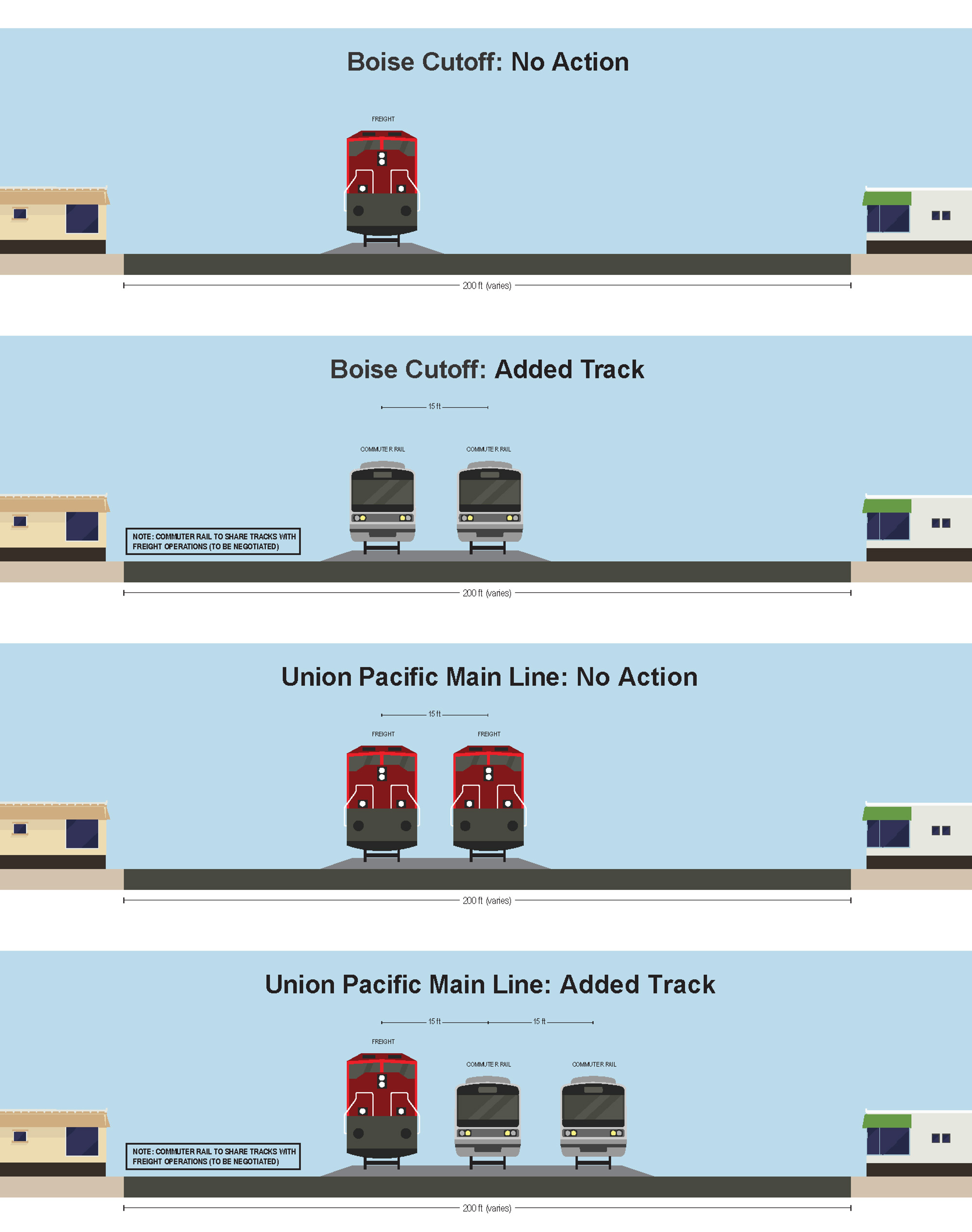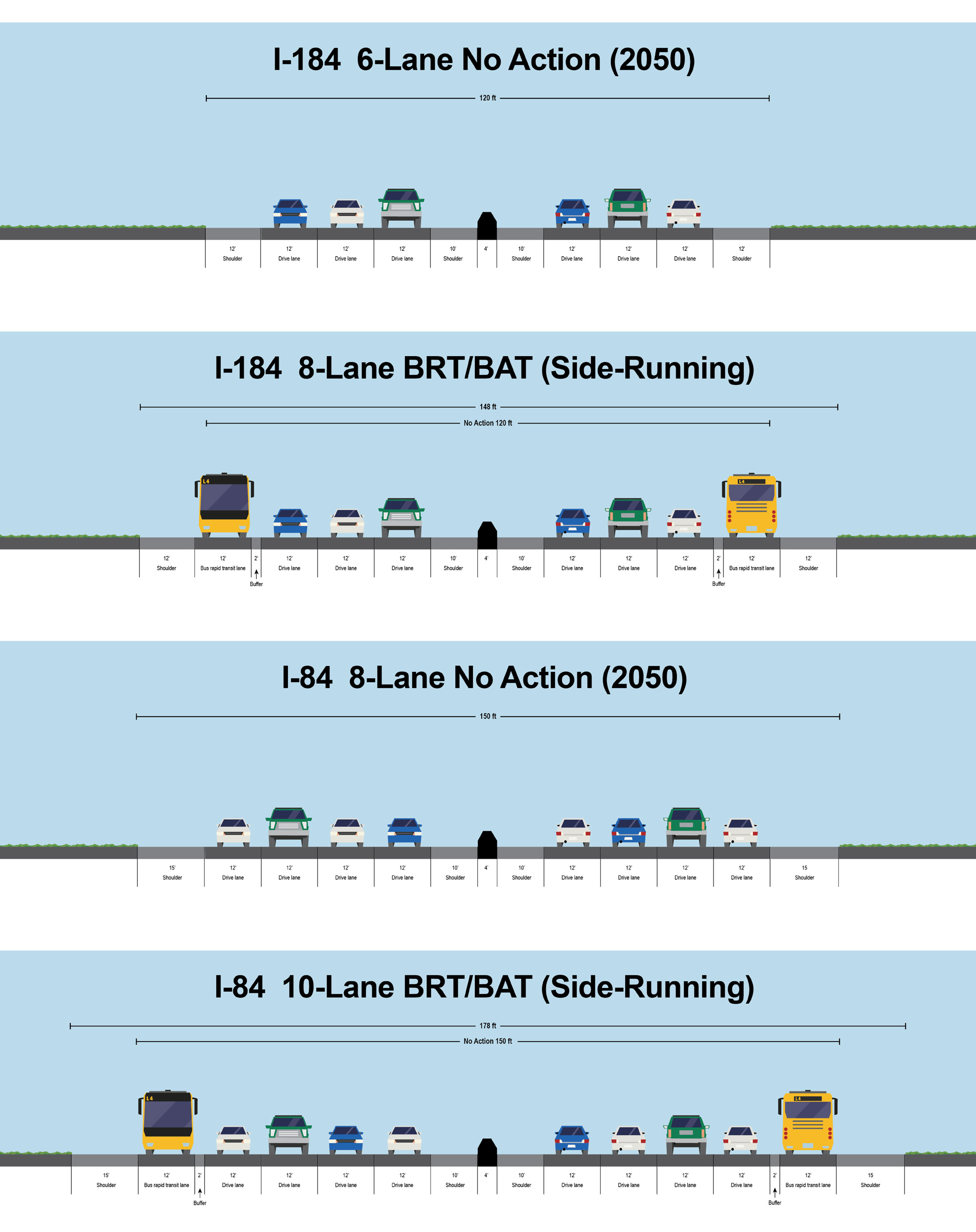Study Background
To learn more about the background of the study, click on each of the topics below.
This study builds on several previous planning efforts.
-
2003
Rail Corridor Evaluation Study
Initial examination of rail transit options -
2009
Treasure Valley High-Capacity Transit Study
Advanced examination of transit corridors (rail, bus, etc.) -
2020
Treasure Valley High-Capacity Transit Study Update
Update to the 2009 study with new data -
2021
All Aboard High-Capacity Transit Survey
It asked Treasure Valley stakeholders about their travel patterns and thoughts on high-capacity transit. Over 11,700 people responded. Some potential benefits of high-capacity transit they shared included:- Increased mobility and accessibility for people who don't drive
- Positive environmental impacts
- Reduced drinking and driving
- Access to special events
- Saves time, money, and stress
-
Collect
Collect information to define the transportation problem the project seeks to address. -
Utilize
Use information to develop a range of potential transportation solutions including routes and transit technologies. -
Refine
Screen routes against certain factors such as reliability, environmental impacts, and future development and planning. -
Analyze
Analyze how routes perform in the future transportation system. -
Develop
Develop recommendations for the project to move forward including potential phasing. -
Post-PEL project steps
National Environmental Policy Act (NEPA) Analysis
Preliminary Design
(pending project funding) -
Final Design
-
Construction
The PEL process is a formal federal process to help streamline future environmental analysis. The process is guided by the project partners and considers:
-
Transportation issues, opportunities, and priorities
-
Environmental resources concerns and opportunities
The Idaho Transportation Department has developed a great overview video on PEL studies.
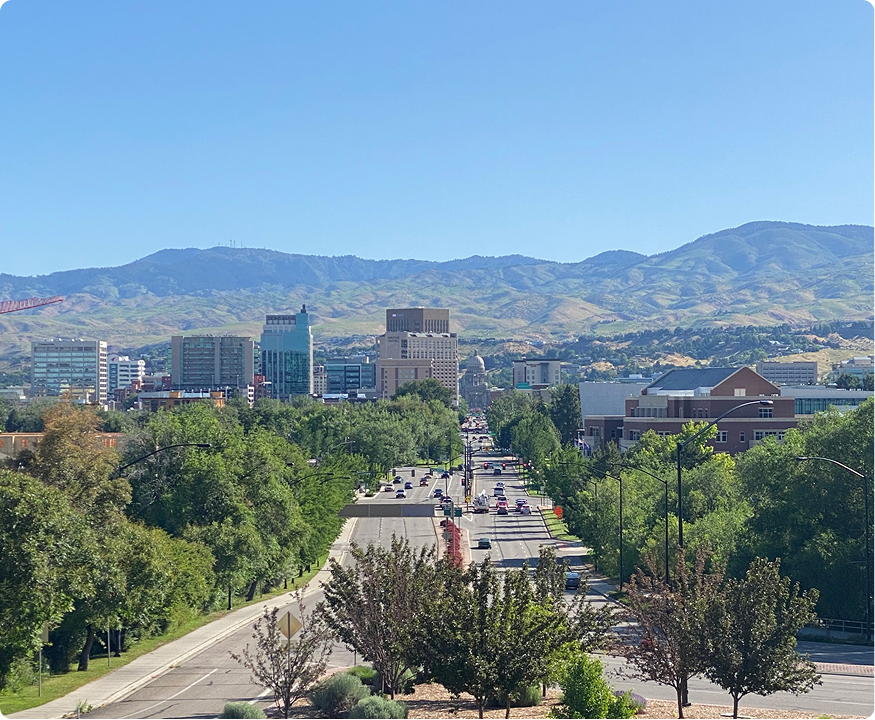
The purpose of the project is to improve the mobility, accessibility, and efficiency of east-west travel between Boise, Meridian, Nampa, and Caldwell, providing reliable and convenient high-capacity transit service that links key origins and destinations with strong potential for transit use.
Key Terms:
- Mobility: Traveling from one place to another
- Accessibility: Ease of entering and exiting a transit stop/station or vehicle
- Efficiency: Transit working well and organized, without wasting time or energy
- Convenience: Making transit simple and intuitive for the user
- Reliability: The transit service arrives and departs as scheduled
Lessen future stress on the region's transportation infrastructure due to population and employment growth.
By 2050, the city areas of Boise, Meridian, Nampa, and Caldwell (within the study area) will account for 78% of the region's jobs.
78%
of the region's jobs
Ada County Population 2000 to 2023
+81% growth
- 2023: 545,000
- 2050: 733,000
- Increase of +35%
Canyon County Population 2000 to 2023
+95% growth
- 2023: 257,000
- 2050: 359,000
- Increase of +40%
Provide greater mobility choice given the region's forecasted deteriorating travel times.
50%
travel time increase
By 2050, travel times between Caldwell and downtown Boise are projected to increase by 50% (peak morning/evening directions).
Transit reliability will continue to degrade with growing congestion.
Support the region's east-west travel patterns.
The region's focused east-west travel patterns will persist between the region's business, governmental, cultural, and educational centers.
By 2050, 31% of all study area commute trips will focus on downtown Boise.
31%
By 2050, 31% of all study area commute trips will focus on downtown Boise.
Our Evaluation Process
The study is structured into three tiers of increasingly more detailed screenings to evaluate the high-capacity transit routes and modes.
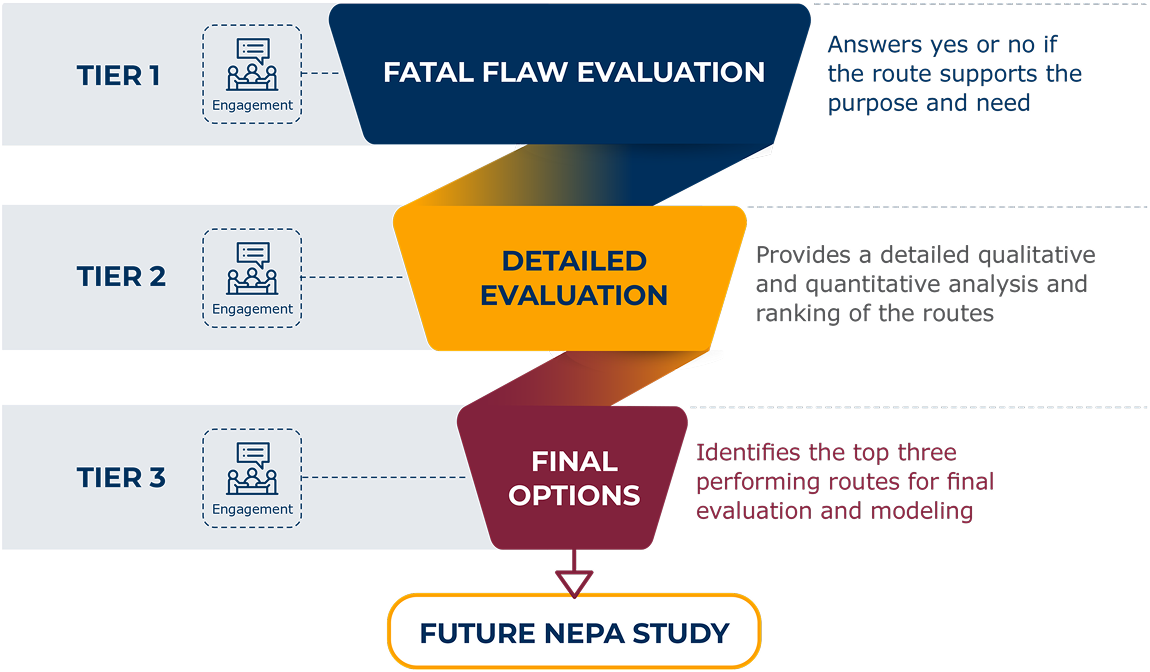
- Tier 1: Fatal Flaw Engagement - Answers yes or no if the route supports the purpose and need
- Tier 2: Details Evaluation - Provides a detailed qualitative and quantitative analysis and ranking of the routes
- Tier 3: Final Options - Identifies the top three performing routes for final evaluation and modeling
- Future NEPA Study
In each tier, Five goals were used to measure and compare the performance of each high-capacity transit option:
-
Improve Transit Connectivity and Mode Share
-
Improve Transit Reliability
-
Expand Travel Choices and Mobility
-
Develop Compatible Plans for High-Capacity Transit, Land Use, and Transportation
-
Advance Financially Feasible Solutions
Work Completed To-Date
Tier 1 Evaluation
The first (“Tier 1”) evaluation examined 10 potential routes to determine if they met the project's purpose and need. Four potential high-capacity transit corridors (Chinden Boulevard, Ustick Road, Overland Road, and Victory/Powerline Road) were removed from consideration primarily because they did not connect as many key activity centers in Boise, Meridian, Nampa, and Caldwell. Four potential corridors (Fairview Avenue/Cherry Lane, Franklin Road, Interstate 84/184, and the Boise Cutoff rail corridor) were advanced to Tier 2. Connection to Micron and the Boise Airport were removed as standalone options, but underwent further consideration. A baseline no-action option was also carried forward.
Tier 2 Evaluation
The second (“Tier 2”) evaluation evaluated transit modes (vehicle type) for the four remaining routes and compared the six transit route/mode options against one another using criteria developed from project goals. This evaluation paired the remaining routes with a type of transit mode, such as light rail, bus rapid transit (BRT), and commuter rail. Light rail was removed as a potential mode as it is about three times the cost of BRT and provides a similar level of service. Additionally, BRT running in mixed traffic was removed because it does not provide the reliability needed for high-capacity transit.
In addition to the baseline no-action option, three route/mode options were carried forward to the Tier 3 evaluation:
- Fairview Avenue/Franklin Road (BRT running in a center-running exclusive lane)
- I-84/I-184 (BRT shoulder/side-running)
- Boise Cutoff (commuter rail)
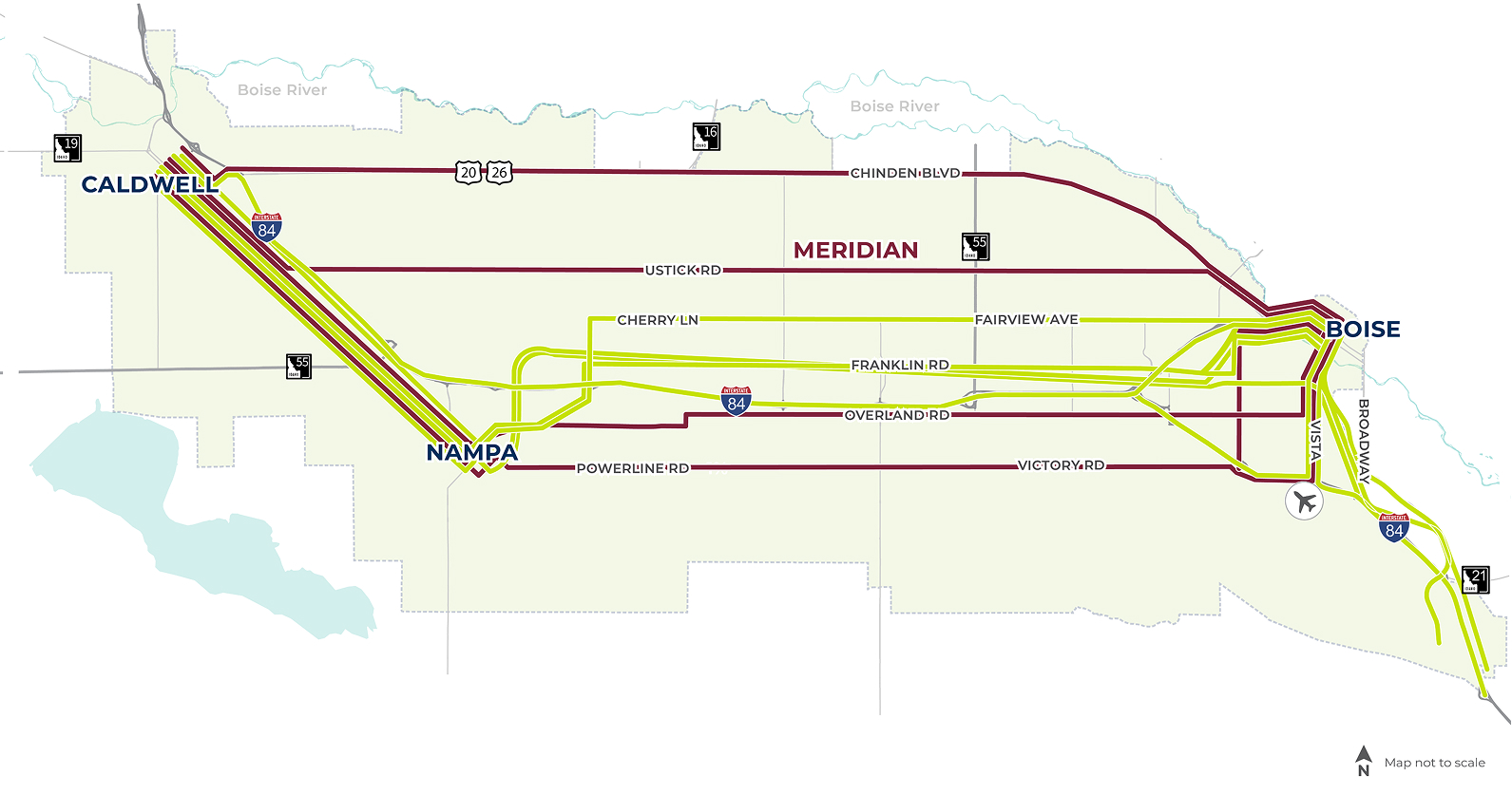
Your Feedback To Date
During Tier 1 and 2 evaluations, we gathered feedback from over 450 community members. All comments were shared with the COMPASS Board of Directors and technical advisory committees and are summarized below.
Tier 1 Feedback Highlights
Strong consensus on the need for improved high-capacity transit solutions to address rapid population growth and traffic congestion in the region.
Respondents ranked the five goals in order of importance. The results are as follows:
- Provide more ways to travel.
- Connect to places with more people and places people want to go.
- Provide more transit, bike, and walking/rolling routes to more destinations.
- Make sure transit arrives and departs as scheduled.
- Ensure that projects are compatible with various funding programs or other relevant opportunities.
Tier 2 Feedback Highlights
Most respondents agreed or mostly agreed (an average of 77%) with the route/mode options proposed to be carried forward to the Tier 3 evaluation.
Respondents ranked the five route/mode options in order of preference. The results are as follows:
- Boise Cutoff Commuter Rail
- I-84/I-184 Bus Rapid Transit
- Fairview Avenue/Cherry Lane Bus Rapid Transit
- None of these - I prefer a different route
- None of these - Don't build it at all (the “No Action” alternative)
Key Comments Vs Action Taken
Individuals also provided open-ended comments in both Tier 1 and Tier 2 engagement. Below is a summary of common themes and with the actions taken in response to that feedback.
| Common Themes | Action |
|---|---|
| Emphasized the need for a high-capacity transit option to address population growth and traffic congestion in the region. | Population growth and increasing travel times are identified as key reasons to implement a high-capacity transit service. |
| Expressed a strong preference for driving. | A baseline no-action option is incorporated in the study. |
| Stressed the importance of connecting key activity centers, essential services, and major intersections. | Station stops were identified to address these key destinations using public feedback and technical analysis. |
| Preferred rail-based transit over bus-based options. | Light rail was removed from consideration, but commuter rail remains under analysis. |
| Wanted the service to connect to the Ten Mile Interchange area. | The Cherry Lane portion of the Fairview Avenue/Cherry Lane route was revised to transition to Franklin Road in downtown Meridian to connect to the Ten Mile Interchange area. |
| Expressed a need to improve the existing bus system before investing in high-capacity transit. | This study will present a proposed implementation plan with phasing options to develop high-capacity transit over time (as funding allows). The new high-capacity transit route and the greater VRT network work in partnership to support one another. High-capacity transit would be a critical spine for transit network, connecting to other VRT services to deliver riders across the region. |
| Wanted high-capacity transit to be integrated with the bicycle, pedestrian, and local bus system, though safety concerns were noted. | Connections to the bicycle, pedestrian, and local bus system are included in the study. Any safety concerns will be identified. |
| Agreed that connections to the Boise Airport and Micron are important to the success of the project but had slightly stronger support for a connection to the Boise Airport. | Both connections have been considered during Tier 3. |
| Wanted the study to evaluate north-south routes | North-south routes are needed, but the study focuses on east-west service, with north-south connections provided by the bus network. |
Station Types
The exact design of stops/stations for high-capacity transit in the Treasure Valley will be determined through future planning; however, the photos below provide examples of what typical stops/stations could look like.
Example BRT stops/stations along an arterial street
Example commuter rail stations
Example BRT stops/stations along a freeway
Tier 3 Route Options and Tentative Station Locations
The following refinements took place during the Tier 3 evaluation:
- Added tentative stop locations based on previous planning, surrounding land use and infrastructure, and spacing assumptions.
- Determined which stops would have designated parking for “park and ride.”
- Developed preliminary operating assumptions and fleet requirements.
- Updated the project footprint based on route revisions and potential station and park and ride locations.
- Developed a hybrid Fairview Avenue/Franklin Road route based on public feedback.
The study team developed tentative transit stop/station locations for all three routes to support the Tier 3 analysis. Existing development and future land use plans were considered when determining these tentative station locations; however, the locations will be further analyzed as planning and design advances beyond this study and may be refined and adjusted.
Click on the options below to view the route options and tentative station locations that were carried forward. Note: The following cross sections show representations of the corridors with and without the transit route in 2050. Multiple cross sections are shown for each corridor to demonstrate what each corridor could look like in different sections with different characteristics (e.g., different numbers of vehicle lanes).
This route is referred to as the Boise Cutoff for simplicity; however, the Boise Cutoff (or Boise Valley Railroad - Watco Railroads) portion of the route only extends from approximately the Boise Depot to the where the rail curves near downtown Nampa. From downtown Nampa to Caldwell, the rail corridor is part of the Union Pacific Railroad's Huntington Subdivision.
Tier 3 Scoring Summary
Below is a summary of how each route/mode combination scored against the others.
| Goal | Screening Criteria | Fairview Ave / Franklin Rd | I-84 / I-184 | Boise Cut-Off |
|---|---|---|---|---|
| BRT Exclusive | BRT | Commuter Rail | ||
| Improve Transit Connectivity and Mode Share | Potential ridership? | Medium Benefits or Impacts | Lowest Benefit or Greatest Impact | Greatest Benefit or Lowest Impact |
| Capacity to accommodate future growth? | Medium Benefits or Impacts | Medium Benefits or Impacts | Greatest Benefit or Lowest Impact | |
| Transit connectivity to/from local routes? | Medium Benefits or Impacts | Medium Benefits or Impacts | Greatest Benefit or Lowest Impact | |
| Potential mode shift and congestion mitigation? | Lowest Benefit or Greatest Impact | Lowest Benefit or Greatest Impact | Medium Benefits or Impacts | |
| Access to critical community services and demographics? | Medium Benefits or Impacts | Medium Benefits or Impacts | Medium Benefits or Impacts | |
| Improve Transit Reliability | Reliability through design and travel time? | Lowest Benefit or Greatest Impact | Medium Benefits or Impacts | Greatest Benefit or Lowest Impact |
| Maintenance facility considerations? | Medium Benefits or Impacts | Medium Benefits or Impacts | Medium Benefits or Impacts | |
| Traffic impacts and challenges? | Lowest Benefit or Greatest Impact | Greatest Benefit or Lowest Impact | Medium Benefits or Impacts | |
| Expand Travel Choice and Mobility | Pedestrian connectivity? | Greatest Benefit or Lowest Impact | Medium Benefits or Impacts | Lowest Benefit or Greatest Impact |
| Bicycle connectivity? | Greatest Benefit or Lowest Impact | Medium Benefits or Impacts | Medium Benefits or Impacts | |
| Develop Compatible Plans for High-Capacity Transit, Land Use, and Transportation | Supports growth and economic development? | Medium Benefits or Impacts | Lowest Benefit or Greatest Impact | Greatest Benefit or Lowest Impact |
| Environmental impacts and benefits? | Lowest Benefit or Greatest Impact | Medium Benefits or Impacts | Medium Benefits or Impacts | |
| Advance Financially Feasible Solutions | Impacts to movement of freight/goods? | Lowest Benefit or Greatest Impact | Greatest Benefit or Lowest Impact | Medium Benefits or Impacts |
| Conceptual capital and operating costs? | Lowest Benefit or Greatest Impact | Greatest Benefit or Lowest Impact | Medium Benefits or Impacts | |
| Funding options? | Medium Benefits or Impacts | Medium Benefits or Impacts | Medium Benefits or Impacts | |
| Corridor preservation? | Lowest Benefit or Greatest Impact | Medium Benefits or Impacts | Greatest Benefit or Lowest Impact | |
| Phasing and constructability? | Lowest Benefit or Greatest Impact | Medium Benefits or Impacts | Greatest Benefit or Lowest Impact | |
| Draft Tier 3 Scoring | Lowest Benefit or Greatest Impact | Medium Benefits or Impacts | Greatest Benefit or Lowest Impact | |
- Greatest Benefit or Lowest Impact
- Medium Benefits or Impacts
- Lowest Benefit or Greatest Impact
Tier 3 Key Results and Differentiators
Through the Tier 3 analysis the study team compared and contrasted each route against the others. The bulleted list highlights the key findings that helped differentiate between the routes as presented in the Scoring Summary graphic.
- Boise Cutoff resulted in the highest projected transit demand.
- Boise Cutoff presented the greatest capacity for peak-hour transit demand growth.
- Boise Cutoff demonstrated the greatest projected benefit to the complete transit system.
- Boise Cutoff resulted in the fastest travel time from Caldwell to Boise.
- Fairview Avenue/Franklin Road provided the best connectivity to the bicycle and pedestrian network.
- I-84/I-184 potentially has the fewest traffic impacts given the free flow nature of the freeway.
- Boise Cutoff has the fewest potential residential and commercial property acquisitions/relocations.
- Boise Cutoff likely has the best potential to preserve the corridor for transit use through coordination with railroads.
Airport and Micron Connections
The Airport Connection and the Micron Connection options were considered with the remaining routes (as appropriate) during the Tier 3 evaluation. Below are considerations for each.
Airport Connection Considerations
- Assessment: Connections to the airport under consideration are BRT on I-84 and/or Vista Avenue or continuing with the Boise Cutoff rail corridor. An existing transit service exists between downtown Boise and the airport (#3 Vista Route). Due to the all-day travel demand needs of the airport, a high-capacity transit service connection to the airport would be beneficial and compatible.
- Preliminary Recommendation: When a locally preferred alternative is selected, design options for an airport connection should be considered at that time, including new service and improvements to existing service.
Micron Connection Considerations
- Assessment: Connections to Micron under consideration are BRT on Vista Avenue and I-84, Federal Way, or continuing with the Boise Cutoff rail corridor. There is no existing transit service to Micron; however, an express route, separate from this study, is planned to connect the cities of Nampa and Meridian to the Boise Airport and Micron. Serving one employer may not require the type of high-capacity transit proposed as part of this study.
- Preliminary Recommendation: Transit demand from downtown Boise to Micron should be assessed as a separate project focused on a service suited to those potential users.
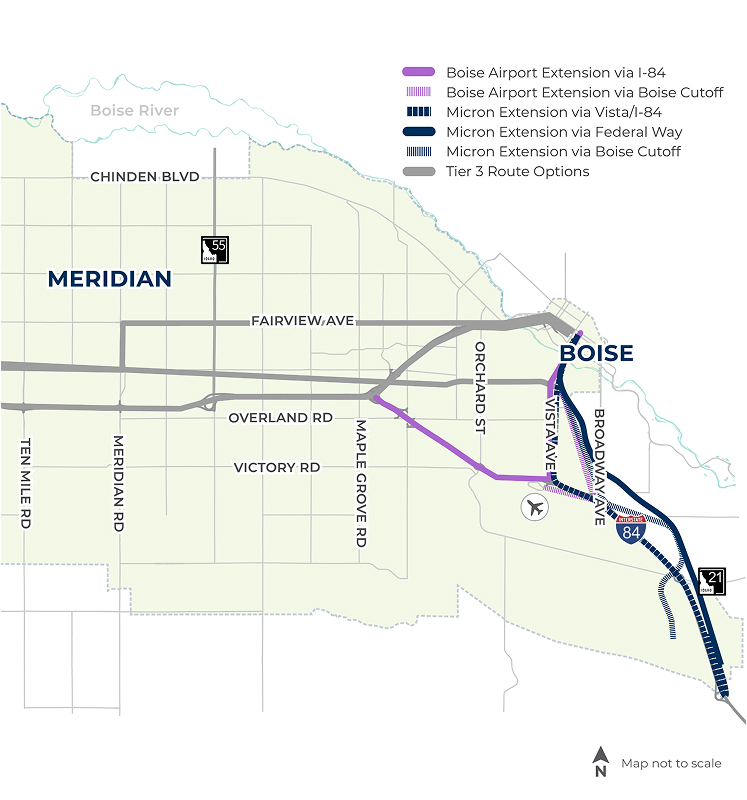
Evaluation Results
Three route options and No Action are proposed to be carried forward.
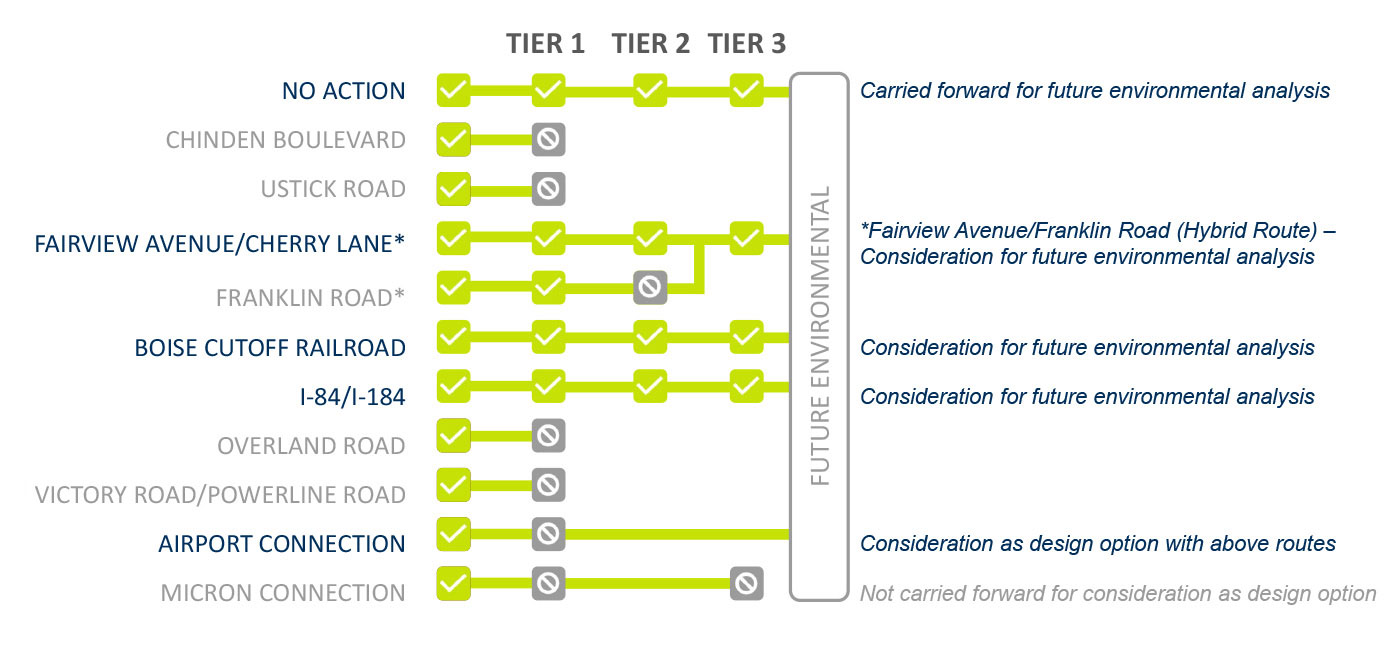
Note: The Communities in Motion 2050 long-range transportation plan includes a list of transportation projects that are reasonably expected to be complete by 2050, given current funding levels. “No Action” assumes that only these transportation projects will be completed by 2050. Each potential high-capacity transit option will be compared to each other and to “No Action” to determine its relative potential benefits and challenges.
The No Action Alternative is advanced as a baseline for further environmental analysis. Any of the remaining routes from this PEL may advance, but the final recommendation(s) will be determined after the consideration of public input.
Tell Us What You Think!
What's Next?
COMPASS and the study team will review your feedback and incorporate it into the final recommendations and implementation plan for high-capacity transit across the Treasure Valley. The final Let's Ride Treasure Valley study will serve as a baseline for further discussion of project funding and implementation steps.
Thank you for your continued participation. Your feedback is critical to the success of this project!
For more information visit https://compassidaho.org/public-transportation-high-capacity-transit/
Comment period is open through June 29.
All draft and final planning products produced during this process may be adopted during a subsequent environmental review process in accordance with 23 USC 168, with the goal of not revisiting during future National Environmental Policy Act (NEPA) processes.






